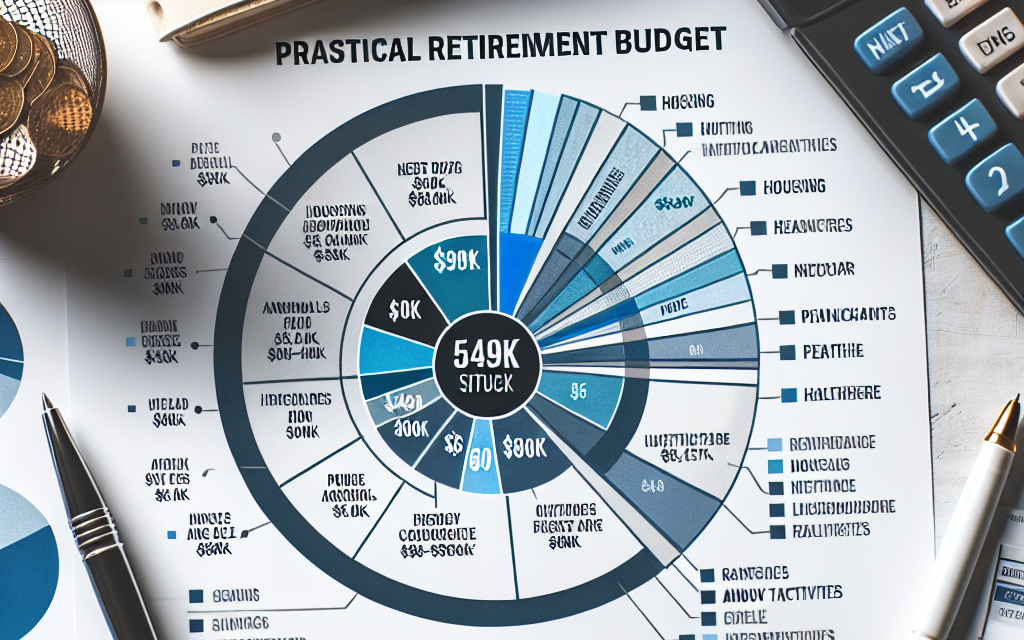“Smart Planning for a Secure Future: Tailoring Your Retirement Budget Today.”
Introduction
Crafting a practical retirement budget is a crucial step for individuals approaching their golden years, ensuring financial stability and peace of mind. For a 55-year-old with $490,000 in savings and an annual income of $80,000, developing a comprehensive plan is essential to balance current lifestyle needs with future financial security. This process involves evaluating current expenses, estimating future costs, and considering potential income sources such as Social Security, pensions, or part-time work. By strategically managing assets and anticipating changes in spending patterns, individuals can create a sustainable budget that supports their desired retirement lifestyle while safeguarding against unforeseen financial challenges.
Understanding Your Retirement Goals: Setting Clear Financial Objectives
Crafting a practical retirement budget is a crucial step for anyone approaching retirement, particularly for a 55-year-old individual with $490,000 in savings and an annual income of $80,000. Understanding your retirement goals and setting clear financial objectives are essential components of this process. As you embark on this journey, it is important to consider various factors that will influence your financial stability in retirement.
To begin with, assessing your current financial situation is paramount. With $490,000 in savings, you have a solid foundation, but it is essential to evaluate how these funds will support your retirement lifestyle. Consider your current expenses and how they might change once you retire. For instance, while some costs such as commuting may decrease, others like healthcare might increase. Therefore, a detailed analysis of your anticipated expenses is necessary to ensure that your savings will suffice.
Moreover, it is important to project your future income sources. In addition to your savings, consider any pensions, Social Security benefits, or other income streams you may have. Estimating these amounts will provide a clearer picture of your financial landscape in retirement. It is advisable to consult with a financial advisor to ensure that your projections are realistic and aligned with your retirement goals.
Transitioning from assessing your current situation to setting clear financial objectives, it is crucial to define what you want your retirement to look like. Do you plan to travel extensively, or do you envision a more modest lifestyle? Your retirement goals will significantly impact your budget. For instance, if travel is a priority, you may need to allocate more funds to leisure activities. Conversely, if you plan to downsize your home, you might reduce housing expenses, freeing up resources for other pursuits.
Furthermore, it is essential to consider the longevity of your retirement savings. With advancements in healthcare, people are living longer, which means your savings need to last potentially 20 to 30 years or more. To address this, consider strategies such as diversifying your investment portfolio to balance risk and return. Additionally, exploring annuities or other financial products that provide a steady income stream can offer peace of mind.
As you refine your financial objectives, it is also important to account for inflation. Over time, the purchasing power of your money will decrease, which can impact your ability to maintain your desired lifestyle. Therefore, incorporating an inflation factor into your budget is crucial. This can be achieved by investing in assets that historically outpace inflation, such as stocks or real estate.
In conclusion, crafting a practical retirement budget involves a comprehensive understanding of your current financial situation, setting clear objectives, and planning for future uncertainties. By carefully evaluating your expenses, income sources, and long-term goals, you can create a budget that supports a fulfilling retirement. Remember, the key to a successful retirement plan is flexibility. As life circumstances change, so too should your budget. Regularly reviewing and adjusting your plan will ensure that you remain on track to achieve your retirement aspirations. With thoughtful planning and a clear understanding of your financial objectives, you can confidently transition into this new phase of life.
Estimating Future Expenses: A Guide to Anticipating Retirement Costs
As individuals approach retirement, the task of estimating future expenses becomes a crucial component of financial planning. For a 55-year-old with $490,000 in savings and an annual income of $80,000, crafting a practical retirement budget requires a thorough understanding of anticipated costs and a strategic approach to managing resources. The first step in this process involves identifying current expenses and projecting how they might change over time. This includes considering inflation, lifestyle changes, and potential healthcare needs, all of which can significantly impact financial stability during retirement.
To begin with, it is essential to categorize current expenses into fixed and variable costs. Fixed expenses, such as housing, insurance, and utilities, are relatively stable and predictable. However, it is important to account for potential increases in these costs due to inflation or changes in living arrangements. For instance, while a mortgage may be paid off by retirement, property taxes and maintenance costs may rise. On the other hand, variable expenses, including groceries, entertainment, and travel, can fluctuate based on lifestyle choices and personal preferences. As retirement often brings more leisure time, it is common for individuals to allocate more funds towards hobbies and travel, necessitating a careful evaluation of these anticipated costs.
Moreover, healthcare is a critical consideration in retirement planning. As individuals age, medical expenses tend to increase, making it vital to estimate these costs accurately. While Medicare provides a safety net for those over 65, it does not cover all medical expenses. Therefore, it is prudent to consider supplemental insurance policies and out-of-pocket costs for services not covered by Medicare. Additionally, long-term care insurance may be a wise investment to protect against the high costs associated with assisted living or nursing home care, which can quickly deplete retirement savings if not planned for adequately.
In addition to healthcare, inflation is another factor that can erode purchasing power over time. Historically, inflation rates have averaged around 3% annually, but this can vary significantly. To mitigate the impact of inflation, it is advisable to include a buffer in the retirement budget. This can be achieved by investing in assets that typically outpace inflation, such as stocks or real estate, thereby preserving the value of savings over the long term.
Furthermore, it is beneficial to consider potential changes in income during retirement. While Social Security benefits will provide a source of income, they may not be sufficient to cover all expenses. Therefore, it is important to determine the optimal time to begin claiming these benefits, as delaying can result in higher monthly payments. Additionally, exploring other income streams, such as part-time work or passive income from investments, can provide financial flexibility and security.
In conclusion, estimating future expenses is a multifaceted process that requires careful consideration of various factors, including current spending habits, potential lifestyle changes, healthcare needs, inflation, and income sources. By taking a comprehensive approach to retirement planning, individuals can create a realistic budget that ensures financial stability and peace of mind in their golden years. For a 55-year-old with $490,000 in savings and an $80,000 income, this means not only safeguarding their current assets but also strategically planning for a future that aligns with their retirement goals and aspirations.
Maximizing Savings: Strategies for Growing Your $490k Nest Egg
As you approach retirement, crafting a practical budget becomes essential, especially when you have a nest egg of $490,000 and an annual income of $80,000. Maximizing your savings during this crucial period can significantly impact your financial security in retirement. To achieve this, it is important to employ strategies that not only grow your existing savings but also ensure a sustainable income stream for the future.
To begin with, evaluating your current financial situation is paramount. Understanding your expenses, debts, and potential future costs will provide a clear picture of your financial landscape. This assessment will help identify areas where you can cut unnecessary expenses and redirect those funds towards savings. For instance, consider downsizing your living arrangements or eliminating luxury expenses that do not contribute to your long-term financial goals. By doing so, you can increase the amount you save each month, thereby enhancing your retirement fund.
In addition to cutting costs, it is crucial to optimize your investment strategy. Diversifying your investment portfolio can mitigate risks and potentially increase returns. Consider a mix of stocks, bonds, and other investment vehicles that align with your risk tolerance and retirement timeline. Consulting with a financial advisor can provide personalized insights and help you make informed decisions. Moreover, taking advantage of tax-advantaged accounts such as 401(k)s or IRAs can further bolster your savings. These accounts not only offer tax benefits but also allow your investments to grow over time, compounding your wealth as you approach retirement.
Furthermore, increasing your income can significantly impact your ability to save more. Exploring opportunities for additional income streams, such as part-time work or freelance projects, can supplement your current earnings. This extra income can be directly funneled into your retirement savings, accelerating your financial growth. Additionally, if you receive bonuses or windfalls, consider allocating a portion of these funds to your retirement account rather than spending them immediately.
Another effective strategy is to delay claiming Social Security benefits. By postponing benefits until you reach full retirement age or even later, you can increase your monthly benefit amount. This decision can provide a more substantial income during retirement, reducing the need to draw heavily from your savings. It is important to weigh the pros and cons of this approach based on your health, life expectancy, and financial needs.
Moreover, managing debt is a critical component of maximizing your savings. Prioritize paying off high-interest debts, such as credit card balances, as they can erode your financial stability over time. By reducing or eliminating these liabilities, you free up more resources to allocate towards your retirement fund. Additionally, consider refinancing options for mortgages or other loans to secure lower interest rates, thereby reducing your monthly obligations.
Lastly, regularly reviewing and adjusting your retirement plan is essential. Life circumstances and financial markets can change, necessitating a reevaluation of your strategy. By staying informed and adaptable, you can make necessary adjustments to ensure your retirement savings continue to grow. This proactive approach will help you maintain financial security and peace of mind as you transition into retirement.
In conclusion, maximizing your $490,000 nest egg requires a multifaceted approach that includes cutting unnecessary expenses, optimizing investments, increasing income, managing debt, and regularly reviewing your financial plan. By implementing these strategies, you can enhance your savings and secure a comfortable retirement, allowing you to enjoy the fruits of your labor without financial stress.
Balancing Income and Expenses: Creating a Sustainable Retirement Budget

Crafting a practical retirement budget is a crucial step for anyone approaching retirement, particularly for a 55-year-old individual with $490,000 in savings and an annual income of $80,000. As retirement looms on the horizon, it becomes increasingly important to balance income and expenses to ensure a sustainable financial future. The first step in this process is to assess current financial standing, which involves a thorough evaluation of assets, liabilities, and expected income streams during retirement. With $490,000 in savings, it is essential to consider how these funds will be allocated to support a comfortable lifestyle in the years to come.
One of the primary considerations in creating a retirement budget is estimating future expenses. This involves distinguishing between essential and discretionary spending. Essential expenses include housing, healthcare, food, and utilities, while discretionary expenses cover travel, entertainment, and hobbies. By categorizing expenses, it becomes easier to identify areas where adjustments can be made if necessary. For instance, downsizing to a smaller home or relocating to an area with a lower cost of living can significantly reduce housing expenses, thereby freeing up funds for other needs.
In addition to managing expenses, it is vital to consider potential income sources during retirement. Social Security benefits, pensions, and investment income are common sources of retirement income. For someone with an annual income of $80,000, it is important to determine how much of this income will continue post-retirement and how much will need to be supplemented by savings. Social Security benefits can be estimated based on current earnings, and it is advisable to explore the impact of different claiming strategies on the overall benefit amount. Additionally, if a pension is available, understanding its terms and payout options is crucial for accurate budgeting.
Investment income is another key component of retirement planning. With $490,000 in savings, it is important to develop an investment strategy that balances growth and risk. Diversifying investments across various asset classes can help mitigate risk while providing opportunities for growth. Consulting with a financial advisor can provide valuable insights into creating a portfolio that aligns with retirement goals and risk tolerance. Moreover, it is essential to consider the impact of inflation on purchasing power and adjust the investment strategy accordingly to preserve the value of savings over time.
Healthcare is another significant factor to consider when crafting a retirement budget. As individuals age, healthcare costs tend to increase, making it imperative to plan for these expenses. Exploring options such as Medicare and supplemental insurance can help manage healthcare costs effectively. Additionally, setting aside funds in a Health Savings Account (HSA) can provide a tax-advantaged way to cover medical expenses in retirement.
Finally, it is important to periodically review and adjust the retirement budget as circumstances change. Life events such as changes in health, unexpected expenses, or shifts in the economic landscape can impact financial plans. Regularly revisiting the budget ensures that it remains aligned with current needs and goals. By taking a proactive approach to retirement planning and budgeting, a 55-year-old with $490,000 in savings and an $80,000 income can create a sustainable financial future that supports a comfortable and fulfilling retirement.
Healthcare Planning: Preparing for Medical Costs in Retirement
As individuals approach retirement, the importance of meticulous financial planning becomes increasingly evident, particularly in the realm of healthcare. For a 55-year-old with $490,000 in savings and an annual income of $80,000, crafting a practical retirement budget necessitates a comprehensive understanding of potential medical costs. Healthcare expenses are a significant concern for retirees, often consuming a substantial portion of their budget. Therefore, preparing for these costs is crucial to ensure financial stability and peace of mind during retirement.
To begin with, it is essential to recognize that healthcare costs tend to rise with age. As individuals transition from employer-sponsored health insurance to Medicare, understanding the nuances of Medicare coverage becomes imperative. While Medicare provides a foundational level of coverage, it does not encompass all medical expenses. For instance, long-term care, dental, vision, and hearing services are often not covered, necessitating additional planning. Consequently, retirees should consider supplemental insurance plans, such as Medigap or Medicare Advantage, to bridge these gaps and mitigate out-of-pocket expenses.
Moreover, it is prudent to anticipate the potential for increased healthcare needs as one ages. Chronic conditions, prescription medications, and routine medical visits can significantly impact a retiree’s budget. Therefore, incorporating a buffer for unexpected medical expenses into the retirement budget is advisable. This can be achieved by setting aside a portion of savings specifically earmarked for healthcare costs, ensuring that funds are readily available when needed.
In addition to traditional insurance options, Health Savings Accounts (HSAs) offer a valuable tool for managing healthcare expenses in retirement. HSAs provide a tax-advantaged way to save for medical costs, allowing individuals to contribute pre-tax dollars, which can grow tax-free and be withdrawn tax-free for qualified medical expenses. For those who are eligible, maximizing contributions to an HSA during their working years can significantly bolster their ability to cover healthcare costs in retirement.
Furthermore, it is important to consider the potential impact of inflation on healthcare expenses. Medical costs have historically risen at a rate higher than general inflation, posing a challenge for retirees on a fixed income. To counteract this, retirees should periodically review and adjust their retirement budget to account for inflationary pressures. This proactive approach ensures that their financial plan remains robust and capable of accommodating rising healthcare costs over time.
Another critical aspect of healthcare planning in retirement is long-term care. As life expectancy increases, the likelihood of requiring long-term care services also rises. These services, which include assistance with daily activities and medical care for chronic illnesses, can be prohibitively expensive. Therefore, exploring long-term care insurance options is advisable. Such insurance can provide financial protection and alleviate the burden of long-term care costs, preserving the retiree’s savings for other essential expenses.
In conclusion, preparing for medical costs in retirement is a multifaceted endeavor that requires careful consideration and strategic planning. For a 55-year-old with $490,000 in savings and an $80,000 income, understanding the intricacies of Medicare, exploring supplemental insurance options, utilizing HSAs, accounting for inflation, and considering long-term care insurance are all vital components of a comprehensive healthcare plan. By addressing these elements, retirees can craft a practical retirement budget that ensures their healthcare needs are met without compromising their financial security.
Social Security and Pension: Integrating Benefits into Your Budget
As you approach retirement, crafting a practical budget becomes essential to ensure financial stability and peace of mind. For a 55-year-old individual with $490,000 in savings and an annual income of $80,000, integrating Social Security and pension benefits into your budget is a crucial step. Understanding how these benefits fit into your overall financial plan can help you maintain your desired lifestyle while safeguarding against potential economic uncertainties.
To begin with, it is important to have a clear understanding of your expected Social Security benefits. The Social Security Administration provides tools and resources to estimate your future benefits based on your earnings history. By accessing your Social Security statement, you can gain insights into the monthly benefits you are likely to receive upon reaching full retirement age. This information is vital as it forms a foundational component of your retirement income.
In addition to Social Security, if you are entitled to a pension, it is essential to understand the terms and conditions of your pension plan. Pensions can vary significantly in terms of payout options, such as lump-sum distributions or annuity payments. Evaluating these options in the context of your overall financial situation will help you make informed decisions that align with your retirement goals. Consulting with a financial advisor can provide valuable guidance in navigating these choices.
Once you have a clear picture of your expected Social Security and pension benefits, the next step is to integrate these into your retirement budget. Begin by calculating your anticipated monthly income from these sources. This will serve as a baseline for your budget, allowing you to assess how much additional income you may need from your savings and investments to meet your expenses.
It is also important to consider the timing of when you will begin receiving these benefits. For instance, delaying Social Security benefits beyond your full retirement age can result in increased monthly payments, which may be advantageous if you anticipate a longer retirement period. Similarly, understanding the implications of early or delayed pension withdrawals can impact your financial strategy.
Moreover, as you incorporate these benefits into your budget, it is crucial to account for inflation and potential changes in your cost of living. While Social Security benefits are adjusted for inflation, pensions may not always offer the same protection. Therefore, maintaining a diversified investment portfolio that can generate additional income and hedge against inflation is advisable.
Furthermore, healthcare costs are a significant consideration in retirement planning. Medicare eligibility typically begins at age 65, but understanding the coverage options and potential out-of-pocket expenses is essential for accurate budgeting. Allocating a portion of your budget to healthcare expenses will help ensure that you are prepared for any medical needs that may arise.
In conclusion, integrating Social Security and pension benefits into your retirement budget requires careful planning and consideration. By understanding your expected benefits, evaluating payout options, and accounting for inflation and healthcare costs, you can create a comprehensive financial plan that supports your retirement goals. With a strategic approach, you can confidently transition into retirement, knowing that your financial future is secure.
Lifestyle Adjustments: Adapting to a Fixed Income in Retirement
As individuals approach retirement, the transition from a regular paycheck to a fixed income can be a significant adjustment. For a 55-year-old with $490,000 in savings and an annual income of $80,000, crafting a practical retirement budget is essential to ensure financial stability and peace of mind. This process involves a careful evaluation of current expenses, anticipated changes in spending habits, and strategic planning to accommodate a potentially reduced income.
To begin with, understanding current spending patterns is crucial. This involves a detailed analysis of monthly expenses, including housing, utilities, groceries, transportation, healthcare, and discretionary spending. By categorizing these expenses, one can identify areas where adjustments may be necessary. For instance, while housing costs may remain relatively stable, other areas such as transportation and work-related expenses might decrease significantly upon retirement. This shift provides an opportunity to reallocate funds towards other priorities, such as healthcare or leisure activities.
Moreover, it is important to anticipate changes in healthcare costs, which often increase with age. Allocating a portion of the retirement budget to cover potential medical expenses is prudent. This may include premiums for Medicare or supplemental insurance, out-of-pocket costs for prescriptions, and routine medical visits. By planning for these expenses in advance, retirees can avoid unexpected financial strain and ensure access to necessary healthcare services.
In addition to healthcare, retirees should consider the impact of inflation on their fixed income. Over time, the purchasing power of savings may diminish, making it essential to incorporate inflation into the retirement budget. This can be achieved by investing a portion of the savings in assets that have the potential to outpace inflation, such as stocks or real estate. By doing so, retirees can help preserve their financial security and maintain their standard of living throughout retirement.
Furthermore, lifestyle adjustments may be necessary to align with a fixed income. This could involve downsizing to a smaller home, relocating to an area with a lower cost of living, or reducing discretionary spending on non-essential items. While these changes may require some sacrifice, they can also provide an opportunity to simplify one’s lifestyle and focus on what truly matters. For instance, spending more time on hobbies, volunteering, or traveling can enrich the retirement experience without incurring significant costs.
Additionally, retirees should explore ways to supplement their income if needed. This might include part-time work, consulting, or turning a hobby into a small business. Such endeavors not only provide additional financial resources but also offer a sense of purpose and engagement during retirement. However, it is important to balance these activities with the desire for leisure and relaxation, ensuring that retirement remains a fulfilling and enjoyable phase of life.
Finally, regular review and adjustment of the retirement budget are essential. As circumstances change, whether due to health, market conditions, or personal preferences, the budget should be revisited to ensure it remains aligned with current needs and goals. By maintaining flexibility and adaptability, retirees can navigate the challenges of living on a fixed income while enjoying the rewards of a well-planned retirement.
In conclusion, crafting a practical retirement budget for a 55-year-old with $490,000 in savings and an $80,000 income involves careful planning and thoughtful lifestyle adjustments. By understanding current expenses, anticipating future needs, and remaining flexible, retirees can successfully adapt to a fixed income and enjoy a financially secure and fulfilling retirement.
Q&A
1. **How much should be allocated for essential expenses?**
Essential expenses typically include housing, utilities, groceries, healthcare, and transportation. A common guideline is to allocate about 50-60% of your income to these necessities. For an $80k income, this would be approximately $40k to $48k annually.
2. **What portion of income should go towards savings and investments?**
It’s advisable to save at least 15-20% of your income for retirement. With an $80k income, this would mean setting aside $12k to $16k annually to bolster your retirement savings.
3. **How should discretionary spending be managed?**
Discretionary spending, which includes dining out, entertainment, and travel, should ideally be around 20-30% of your income. For an $80k income, this equates to $16k to $24k annually.
4. **What role does debt repayment play in the budget?**
If you have existing debt, prioritize paying it off before retirement. Allocate a portion of your budget to debt repayment, ensuring it doesn’t exceed 20% of your income, or $16k annually.
5. **How can healthcare costs be planned for?**
Healthcare costs can rise with age, so it’s crucial to allocate a portion of your budget for this. Consider setting aside at least 10-15% of your income, or $8k to $12k annually, for healthcare expenses.
6. **What strategies can be used to maximize retirement savings?**
Maximize contributions to retirement accounts like 401(k)s or IRAs, take advantage of employer matches, and consider catch-up contributions if eligible. Diversify investments to balance risk and growth potential.
7. **How can lifestyle adjustments impact the retirement budget?**
Downsizing your home, relocating to a lower-cost area, or reducing discretionary spending can significantly impact your budget. These adjustments can free up more funds for savings and essential expenses, enhancing financial security in retirement.
Conclusion
In crafting a practical retirement budget for a 55-year-old with $490,000 in savings and an $80,000 annual income, it is crucial to balance current lifestyle needs with future financial security. The individual should focus on maximizing savings contributions, particularly to tax-advantaged retirement accounts, while also considering investment strategies that align with their risk tolerance and retirement timeline. Additionally, it is important to account for potential healthcare costs, inflation, and life expectancy in retirement planning. By maintaining a disciplined approach to budgeting and saving, and possibly seeking professional financial advice, the individual can work towards achieving a comfortable and sustainable retirement.





